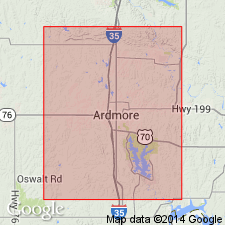
- Usage in publication:
-
- Lester limestone member
- Modifications:
-
- Named
- Dominant lithology:
-
- Limestone
- AAPG geologic province:
-
- South Oklahoma folded belt
Summary:
Named as a member of Dornick Hills formation (new) in Ardmore basin of southern OK. Was formerly included with Cup Coral member north of Ardmore and with Deese member south of Ardmore (Goldston, 1922). Named for the D. B. Lester farm, about 800 ft south of the NE corner sec 13, T4S, R1E, Carter Co, OK in the S. Oklahoma folded belt province, [its type locality?]. Consists of white, rather coarsely crystalline limestone with considerable oolite at the type locality, but much less elsewhere. Maximum thickness is about 20 ft. Interval between Bostwick member (new) of the Dornick Hills formation and Lester north of Ardmore is 400 to 500 ft, but it increases southward to twice this figure. Included in this interval are two or three other highly fossiliferous limestones which range from a few inches to two ft thick. Lies about 150 ft below Pumpkin Creek member (new) of the Dornick Hills. Overlies and underlies unnamed shale of Dornick Hills. Bryozoans of the FENESTELLA type present. Fossil list; geologic map; columnar section. Of Pennsylvanian age.
Source: GNU records (USGS DDS-6; Denver GNULEX).
For more information, please contact Nancy Stamm, Geologic Names Committee Secretary.
Asterisk (*) indicates published by U.S. Geological Survey authors.
"No current usage" (†) implies that a name has been abandoned or has fallen into disuse. Former usage and, if known, replacement name given in parentheses ( ).
Slash (/) indicates name conflicts with nomenclatural guidelines (CSN, 1933; ACSN, 1961, 1970; NACSN, 1983, 2005, 2021). May be explained within brackets ([ ]).

